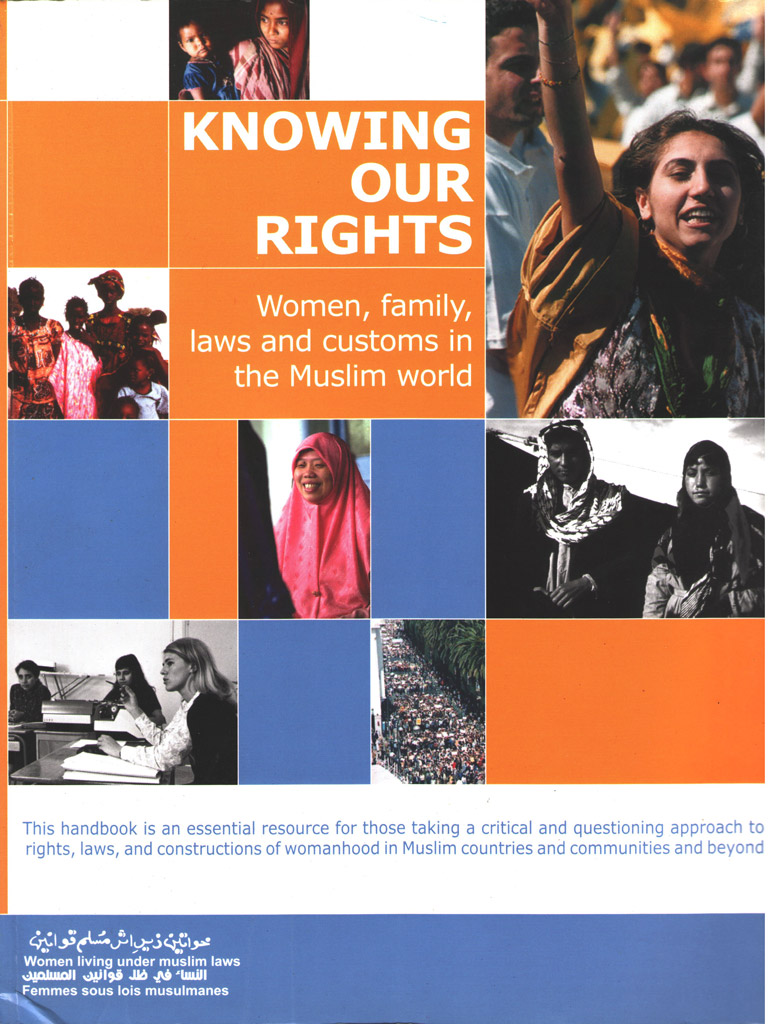
Knowing Our Rights: Women, family, laws and customs in the Muslim world
Publication Author: Women Living Under Muslim Laws (WLUML)
In much of the Muslim world, women’s lack of knowledge about statutory provisions and about the sources of customs and practices applied in their immediate community obstructs their ability to change their circumstances. This understanding was the basis for the Women & Law in the Muslim World Programme of the international solidarity network, Women Living Under Muslim Laws (WLUML).
Our action-research sought to examine and analyze how customs, laws and culture interact to define women’s lives and how the dynamics of religion and politics intersect with this.
Knowing Our Rights forms part of the international synthesis of the Women & Law in the Muslim World Programme and is based on some 10 years of field experience, research, analysis by multi-disciplinary teams of networkers in over 20 countries across Asia, Africa and the Middle East. These include majority and minority Muslim communities; communities which are governed by family laws based on Muslim laws and those which are subject to a general law applicable to all communities; legal systems that formally recognize customary laws, and those that do not; as well as diverse (and changing) political situations.
Research on women in the family was of principal importance because it is in the family that we experience imposed definitions of gender-appropriate roles on a daily basis.
This Handbook is an essential resource for those taking a critical and questioning approach to rights, laws, and constructions of womanhood in Muslim countries and communities and beyond.
HISTORY
The need for a Women & Law in the Muslim World action-research programme was identified in WLUML’s 1986 Aramon Plan of Action, and crystallized during WLUML’s first 2 two collective projects – 1988 Exchange Programme and the Qur’anic Interpretations Meeting of 1990.
AIMS
- To unravel how custom, culture and law combine to structure women’s lives in Muslim countries and communities;
- To highlight how the dynamics of religion and politics shape these combinations;
- To demystify what is presented as ‘law’ to women;
- To examine the options available to women in law;
- To understand what the processes of legal construction and reform involve.
- To identify individual and collective strategies to increase women’s rights and space, & resist reactionary trends in legal interpretation and community practice;
- To resist fundamentalist claims to a sole truth or homogenous reality.
Example: Polygamy is customarily mandated in some sections of the Muslim community in Nigeria, permitted without restrictions (other than the number of wives) in India; permitted provided the wives are given separate residences in Sudan; permitted only with court oversight in Malaysia; and altogether prohibited in Tunisia. Moreover, all of these systems claim Islam as the justification for their laws and practices. What is assumed to be ‘Muslim’ in one community may be unknown, or even be considered ‘unIslamic’, in other Muslim communities.
Such knowledge is vital to those taking a critical and questioning approach to rights, laws, and constructions of womanhood. Women in all contexts, whether secular or where laws are framed with reference to Islam need this information because of extreme right-wing politico-religious movements are rising in all contexts.
METHODOLOGY, PRINCIPLES AND PREMISES
The Handbook, Knowing Our Rights, is the result of some 10 years of research and collective analysis, which has at various points involved almost all active networkers linked through WLUML.
Methodology included:
- Legal-archival research, field research, textual analysis, secondary data;
- A comparative and historical approach (especially focusing on the influence of colonial laws and legal structures);
- Multidisciplinary teams included social scientists, writers and lawyers, all with a background in and commitment to women’s rights activism.
Premises:
- The reality of law in women’s lives cannot be read from legal texts, especially because some laws are uncodified and customary practices are recognised by some laws;
There is a need to distinguish between:
- law (enacted legislation or legal interpretations established by court judgments), implementation (if & how the agencies with the responsibility for enforcing law do so)
- practices (what women, or other sectors of the community, actually do).
DIVERSE CONTEXTS, SHARED THEMES
About 20 W&L Country Projects: Bangladesh, Cameroon, Fiji, the Gambia, India, Indonesia, Iran, Malaysia, Morocco, Nigeria, Pakistan, Philippines, Senegal, Sri Lanka, Sudan, Turkey; partial research was also carried out in the former Soviet Central Asian republics of Uzbekistan, Kazakhstan and the Kyrgyz Republic.
The Handbook also includes data and analysis regarding: Egypt, Tunisia, Yemen, Lebanon, Saudi Arabia given the significance of these countries in the development of family laws.
The Handbook compares:
- Majority and minority Muslim communities;
- Where secular law is the norm vs. those where Islam is the state religion, and/or where family laws are based on personal laws derived from religious sources;
- Legal systems that formally recognize customary laws, and those that do not;
- Situations where citizens can choose amongst varied legal systems, and those where there is no such choice;
- Diverse (and changing) political situations.
The 1992 Lahore W&L planning meeting developed a common list of research themes but gave each country team the autonomy to choose its research focus. The research was concentrated on three themes:
- women in the family,
- women’s individual and bodily rights
- women as citizens.
The theme of women in the family is the focus of this first volume because the family is the site of women’s greatest oppression and the interconnection of laws, religion, custom). Also, very often laws and customs relating to marriage, rights within marriage, and divorce determine women’s choices in relation to the other two themes.
Limitations of the Handbook
- It cannot be definitive because the law and society are ever-changing;
- Some limitations because of capacity of W&L teams;
- International synthesis inevitably sacrifices depth for the sake of breadth;
- Customary practices vary from village to village and so information on this will only be partial.
HANDBOOK FORMAT AND STRUCTURE
- About 26 topics, each section contains an overview of issues, comparative laws table, implementation & practices & case studies;
- The emphasis is on comparing more vs. less option-giving laws using the framework of women’s human rights;
- Some laws we didn’t rank: e.g., regarding mahr because its meaning and value are disputed by feminists in Muslim countries and communities;
- Some laws presented real challenges to rank laws as more or less option-giving for women because the law affects each woman so differently according to her particular circumstances, e.g., registration & validity/non-validity of marriage; polygamy; and child marriage.
UNDERSTANDINGS: Implications for Agencies and NGOs
- No single system or set of laws stands out as ‘the best’ to be copied indiscriminately; activists and those who support them must have a conscious desire to avoid the pitfalls of both cultural relativism (“It’s ‘their culture’ so we must refrain from supporting change”) and universalism (“women’s human rights can only be fulfilled in a liberal democracy modelled on western countries”);
- Muslim countries and communities are diverse and must not be homogenised – there is no one understanding of ‘Muslim law’ or ‘Sharia’;
- It is essential to distinguish between law, custom and religion – the question ‘Does Muslim law allow women divorce?’ is simply the wrong question!
- There are examples of ‘secular’ systems offering women few rights and of ‘Islamic’ systems offering women broad rights. Therefore the issue is not secular vs. Muslim frameworks but how far women’s rights are upheld/protected by whatever the system is.
- Women in Muslim countries and communities are the best judges of whether or not their rights are being violated and what is the best solution/strategy.
- Procedure and implementation mechanisms play an equally important part in determining how far women are able to access their rights.
- When using law reform as a tool for developing and protecting women’s rights, activists and those who support them must take into account other areas that will be impacted.
For example, laws on divorce need to be cross-referenced with provisions on mahr (is it recoverable or is it returnable?), child custody (will the mother retain custody of her children?), marital property (will the woman be given a share of that property?), etc; provisions regarding polygyny need to be examined in the light of provisions regarding maintenance (can a co-wife approach the courts to demand equal maintenance, is this a condition for polygyny?), registration of marriage (can a polygynous marriage be registered), divorce (can a wife seek divorce if her husband contracts a polygynous marriage in violation of polygyny regulations?), mahr (does it become due when her husband contracts another marriage?), property rights (how is marital property divided in polygynous households?), and the possibility of negotiating stipulations in a marriage contract (can the wife demand that the marriage remain monogamous, or does the husband have to choose whether the marriage will be monogamous or polygynous?). - Activists and those who support them must not forget the interactions of family law with civil law, criminal law, court structures, constitutions, judicial training facilities, etc. These will all determine how easy it is for women to access their rights in reality – quite apart from other non-legal social limitations.
Agencies and NGOs need to:
- Strengthen and facilitate exchanges, especially cross-regional, between women from diverse contexts;
- Recognise women’s agency and traditional power mechanisms that women can access;
- Strengthen and support grassroots capacity-building: women do not need to be told they are oppressed but need the skills to enable them to effectively determine and demand their rights;
- Recognise that reform of the law is not the easiest or only solution. Most countries have reasonable laws, but judicial attitudes, lack of resources & political will lead to negative interpretations and failure to implement positive laws.

